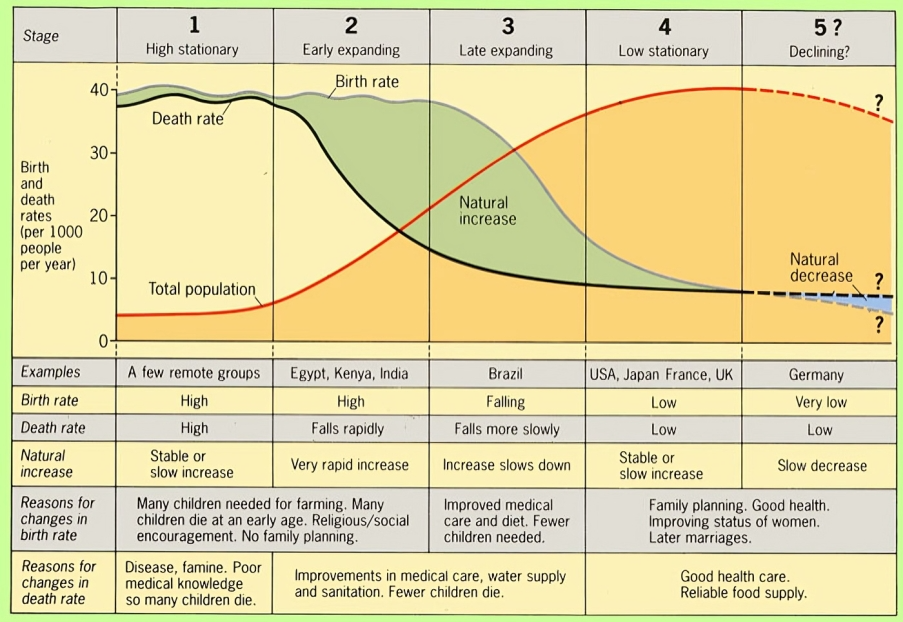-
18 Jan 2025
GS Paper 1
Geography
Day 42: Discuss the global population transition with a focus on the relationship between fertility decline and socio-economic development. (250 Words)
Approach
- Begin with a concise definition of population transition and its connection to fertility and development.
- In the body, discuss stages of population transition, reasons for fertility decline, and socio-economic consequences with examples and data.
- Conclude with a balanced summary addressing the question's broader implications.
Introduction
Population transition, also called the demographic transition, describes the shift from high birth and death rates to low birth and death rates, typically associated with socio-economic progress. This shows how fertility decline, caused by economic and social changes, affects global population patterns and development.
Body
Stages of Population Transition:
- High Stationary Stage:
- This stage is characterized by high birth and death rates, resulting in minimal population growth.
- It was prevalent in pre-industrial societies, where frequent diseases, famines, and lack of medical care kept mortality rates high.
- Early Expanding Stage:
- In this stage, death rates start declining due to advancements in healthcare, improved sanitation, and better nutrition. However, fertility rates remain high, leading to a population explosion.
- For instance, Europe during the Industrial Revolution saw significant growth during this phase.
- Late Expanding Stage:
- Fertility rates begin to decline as socio-economic factors such as urbanization, education, and employment opportunities for women gain prominence.
- Countries like India and Brazil experienced this phase during the 20th century, fueled by family planning initiatives and modernization.
- Low Stationary Stage:
- Both fertility and mortality rates become low and stable, with little or no population growth.
- This stage is evident in developed nations, including Germany and Japan.
- Declining Stage:
- Fertility rates fall below replacement levels, leading to an aging population and eventual decline in total population.
- Countries like Italy and South Korea are currently grappling with the challenges of this phase.
Causes of Fertility Decline:
- Economic Development:
- As countries industrialize and incomes rise, families tend to have fewer children due to high costs of raising children and the shift from agrarian economies to urban centers.
- For example, fertility rates in China dropped significantly following its rapid industrial and economic growth post-1980s.
- Female Education and Employment:
- Higher levels of education and workforce participation among women delay marriage and childbirth, reducing fertility.
- Kerala, India, with its female literacy rate above 90%, exemplifies how education correlates with fertility rates below replacement levels.
- Improved Healthcare:
- Advances in maternal and child healthcare reduce infant mortality rates, leading families to have fewer children.
- Sub-Saharan Africa, though historically marked by high fertility, is witnessing gradual declines due to increasing healthcare access.
- Urbanization and Changing Lifestyles:
- Urban areas tend to have lower fertility rates due to high living costs, career priorities, and shifting social norms.
- Globally, urban areas report lower fertility rates than their rural counterparts.
- Policy Interventions:
- Governments have implemented family planning initiatives to curb population growth. For instance, China’s One-Child Policy reduced fertility drastically, though it also led to demographic imbalances.
Socio-Economic Consequences
- Positive Impacts:
- Demographic Dividend: A decline in fertility may result in a larger working-age population relative to dependents, as seen in East Asian economies like South Korea and Singapore during their economic booms.
- Gender Equality and Empowerment: Lower fertility would allow women to pursue education and careers, leading to enhanced social and economic contributions.
- Resource Optimization: Reduced population pressure eases strain on essential resources like food, water, and energy in regions undergoing transition.
- Negative Impacts:
- Aging Population: In countries like Japan and Germany, low fertility has resulted in a rising proportion of elderly, creating economic burdens through increased healthcare and pension costs.
- Labor Shortages: Fertility decline can lead to insufficient working-age populations, reducing productivity, as seen in Italy and South Korea.
- Rural-Urban Disparities: Fertility rates often decline faster in urbanized areas, exacerbating inequalities between rural and urban regions, particularly in countries like India.
Conclusion
The demographic transition reflects the transformative impact of fertility decline and socio-economic development on population dynamics. While it opens opportunities such as a demographic dividend and improved gender equality, challenges like an aging population and labor shortages demand sustainable policies. A focus on healthcare, education, and inclusive development is crucial for ensuring the benefits of population transition outweigh its challenges.





